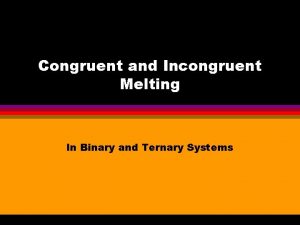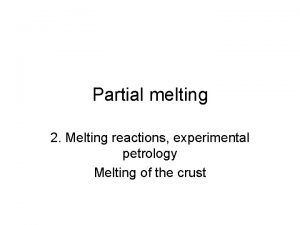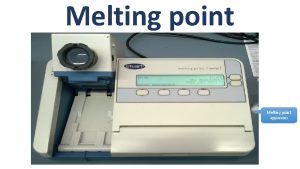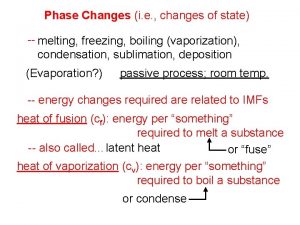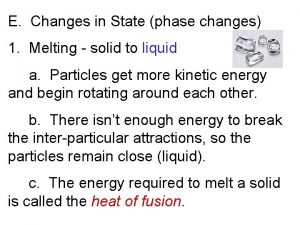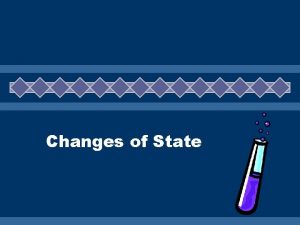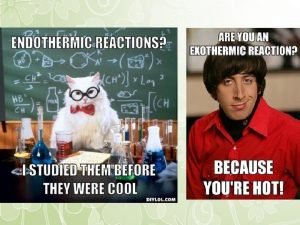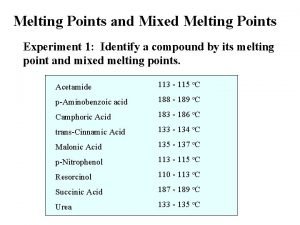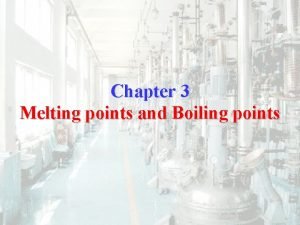Phase Changes i e changes of state melting











- Slides: 11

Phase Changes (i. e. , changes of state) -- melting, freezing, boiling (vaporization), condensation, sublimation, deposition (Evaporation? ) passive process; room temp. -- energy changes required are related to IMFs heat of fusion (cf): energy per “something” required to melt a substance -- also called. . . latent heat or “fuse” heat of vaporization (cv): energy per “something” required to boil a substance or condense

How do magnitudes of cv and > cf compare? KE must be increased IMFs must be enough to allow completely overcome particles to slide, relative (i. e. , “broken”) to each other (IMFs still in effect)

-- specific heat capacity: energy req’d to change temp. of 1 _____ gram of a substance 1 o. C (1 K) -- molar heat capacity: energy req’d to change mole of a substance 1 o. C (1 K) temp. of 1 _____ Heating curves are graphs of temperature v. heat added (or heat removed). Typical Heating Curve for a Pure Substance BP Within a phase: Temp. DH = q = m cp DT MP/FP Between phases: DH = q = +/– m cx Heat Added or Removed

Find the enthalpy change when 82. 4 g of ice at – 13. 5 o. C turns to water at 72. 8 o. C. warm ice to 0 o. C: q = m cp DT q = 82. 4 (2. 077) (0 – – 13. 5) q = 2310 J melt ice at 0 o. C: q = m cf q = 82. 4 (333) = 27439 J Phase Change Constants for Water cp, ice = 2. 077 J/g-K cf = 333 J/g cp, water = 4. 18 J/g-K cv = 2256 J/g cp, wv = 2. 042 J/g-K heat water from 0 o. C to 72. 8 o. C: q = m cp DT q = 82. 4 (4. 18) (72. 8 – 0) = 25075 J qtot = DH = 54. 8 k. J

supercooling: temporarily cooling a liquid below its freezing point without it forming a solid -- heat is removed so quickly that particles have no time to assume an ordered structure critical temperature: the highest temperature at which a substance can be a liquid -- as IMFs increase, crit. temp… increases critical pressure: the pressure required to bring about liquefaction at the critical temp. The intersection of the critical temperature and the critical pressure is called the critical point.

A substance’s vapor pressure is the pressure exerted by a vapor in dynamic equilibrium with its liquid or solid phase. -- as IMFs increase, VP. . . -- as temperature increases, VP. . . -- liquids that evaporate easily are said to be ______ volatile (these have high VPs) Pressure cookers raise the confining pressure on the water, so the water boils at a higher temp. -- boiling occurs when…VP = external pressure (usually from atmos. ) -- normal boiling point (NBP): the boiling temp. of a liquid at 1 atm of pres.

Phase Diagrams -- graphs showing the conditions under which equilibria exist between different states of matter Phase Diagram for a Typical Substance changes in FP/MP P triple point critical point (CT, CP) SOLID LIQUID 1 atm v. p. curve of liquid v. p. curve of solid GAS NFP/NMP NBP T

Water is NOT a typical substance. Its phase diagram differs slightly, as shown below. Phase Diagram for Water P LIQUID s. c. f. SOLID 1 atm GAS T supercritical fluid: how we describe a substance at or beyond its critical point

Structures of Solids amorphous solid: the particles have no orderly structure -- e. g. , rubber, glass -- IMFs are highly variable, so these solids have no specific… MP

crystalline solid: the particles are in well-defined arrangements -- e. g. , ionic and elemental metallic solids -- these melt at VERY specific temps. crystal lattice: a 3 -D array of points showing the crystal’s structure The crystal lattice of sodium chloride (Na. Cl).

unit cells: the repeating units “continuous atomage” of a crystalline solid primitive (or simple) cubic face-centered cubic 1 atom unit cell body-centered cubic 2 atoms unit cell 4 atoms unit cell
 Difference between congruent and incongruent melting point
Difference between congruent and incongruent melting point Normal phase vs reverse phase chromatography
Normal phase vs reverse phase chromatography Hplc reverse phase vs normal phase
Hplc reverse phase vs normal phase Mobile phase and stationary phase
Mobile phase and stationary phase Stationary phase and mobile phase in hplc
Stationary phase and mobile phase in hplc Normal phase vs reverse phase chromatography
Normal phase vs reverse phase chromatography Line vs phase voltage
Line vs phase voltage Which detector used in hplc
Which detector used in hplc Phase to phase voltage
Phase to phase voltage Broad phase vs narrow phase
Broad phase vs narrow phase The change of phase from gas to solid *
The change of phase from gas to solid * 6 phase changes
6 phase changes
